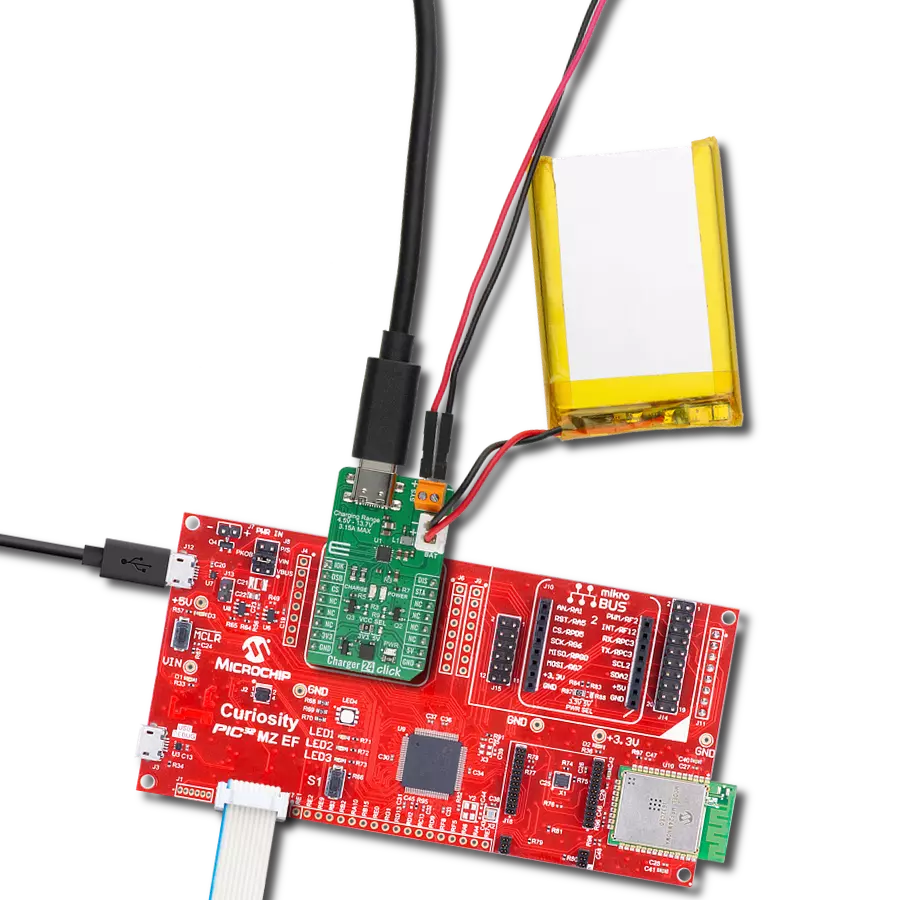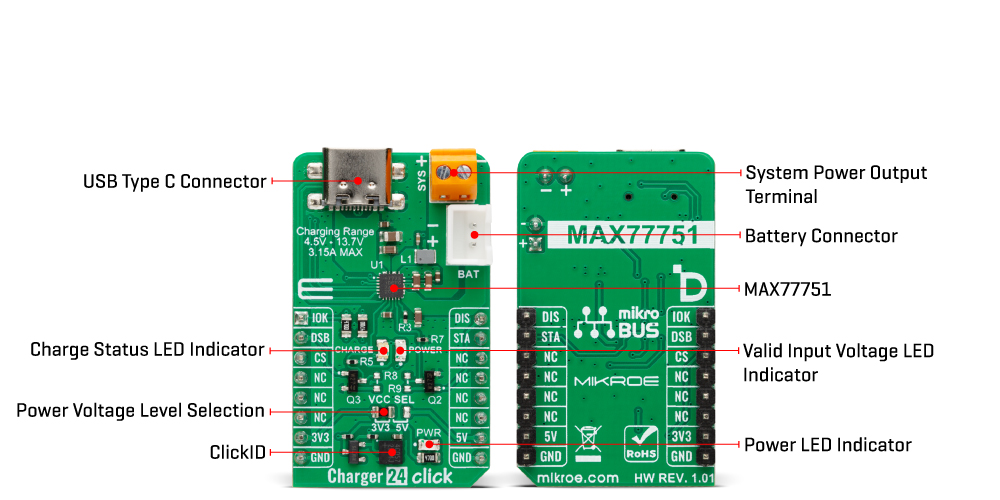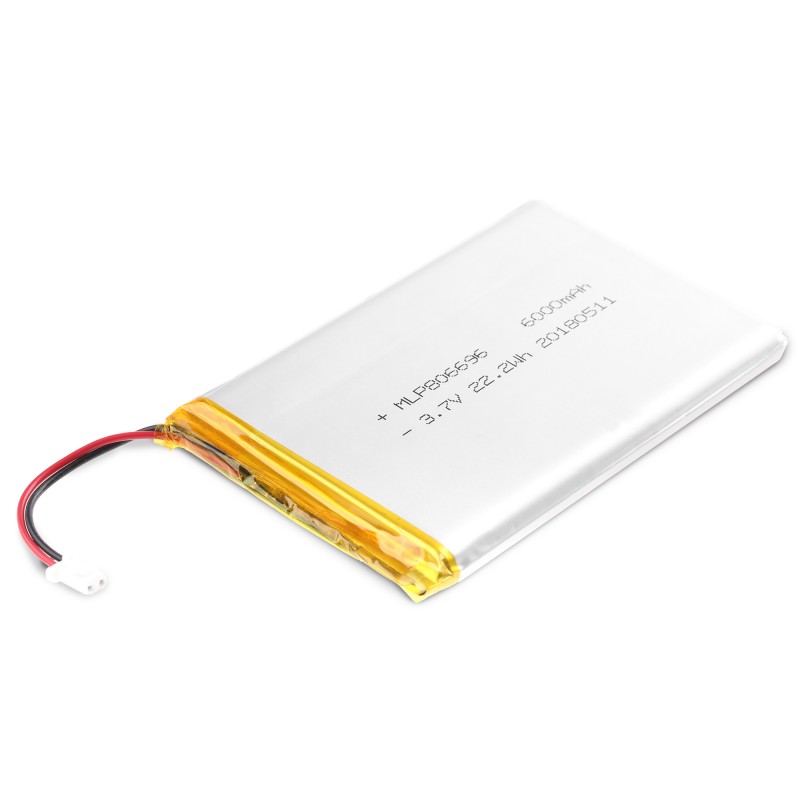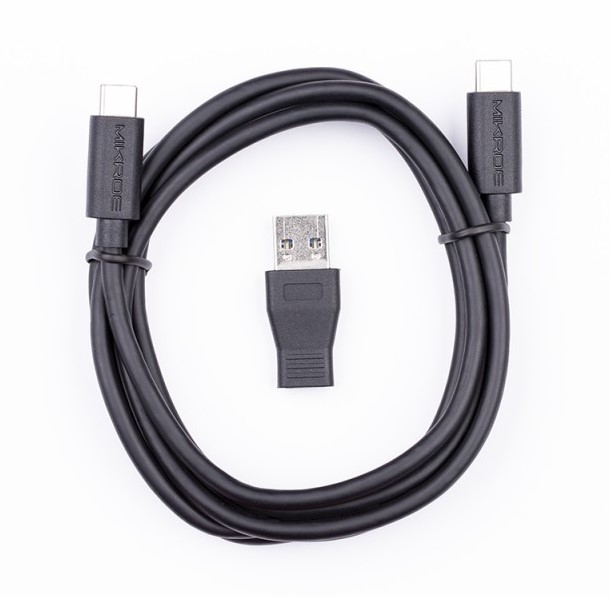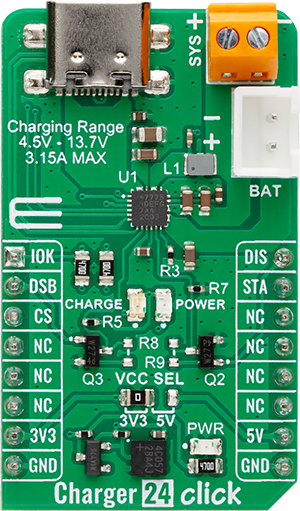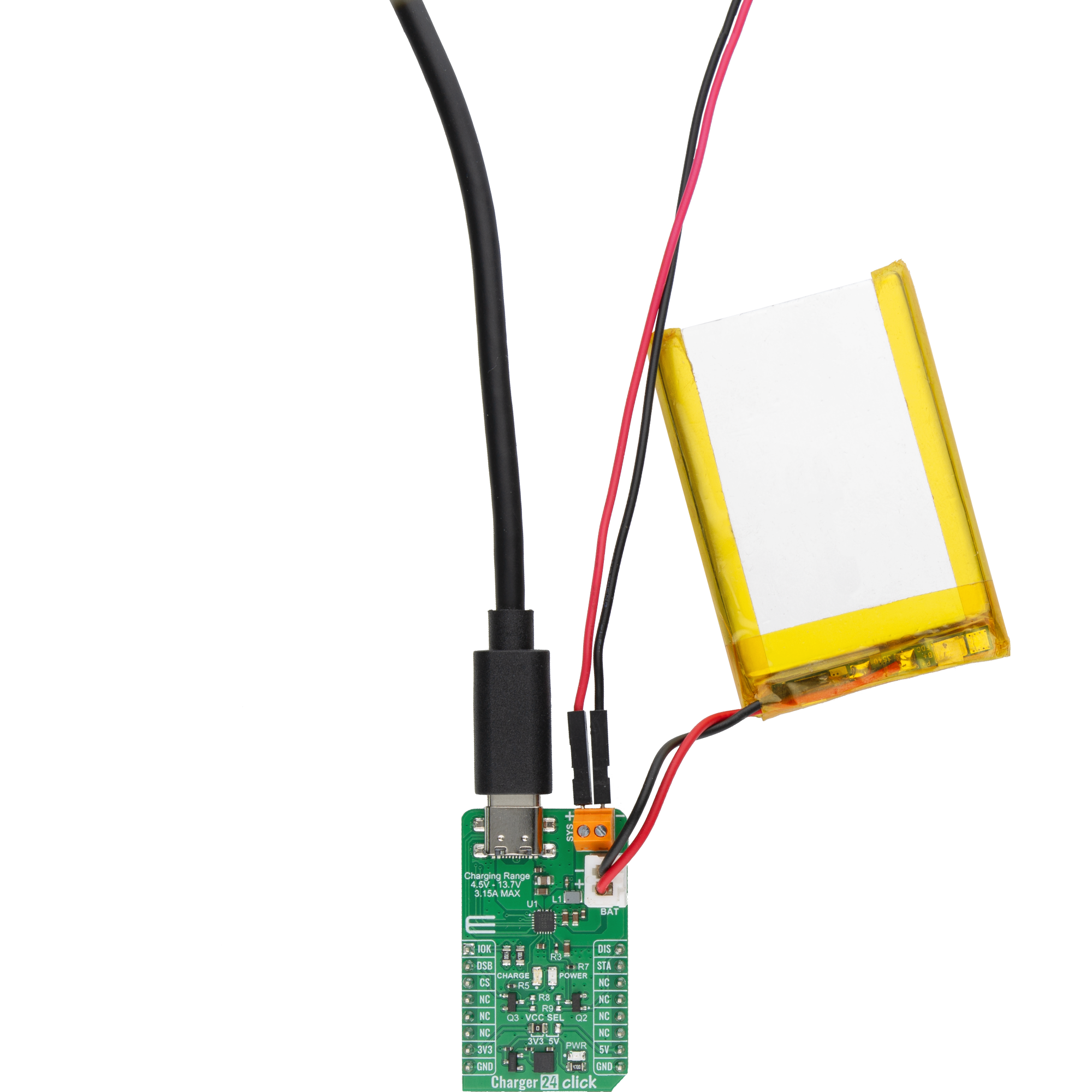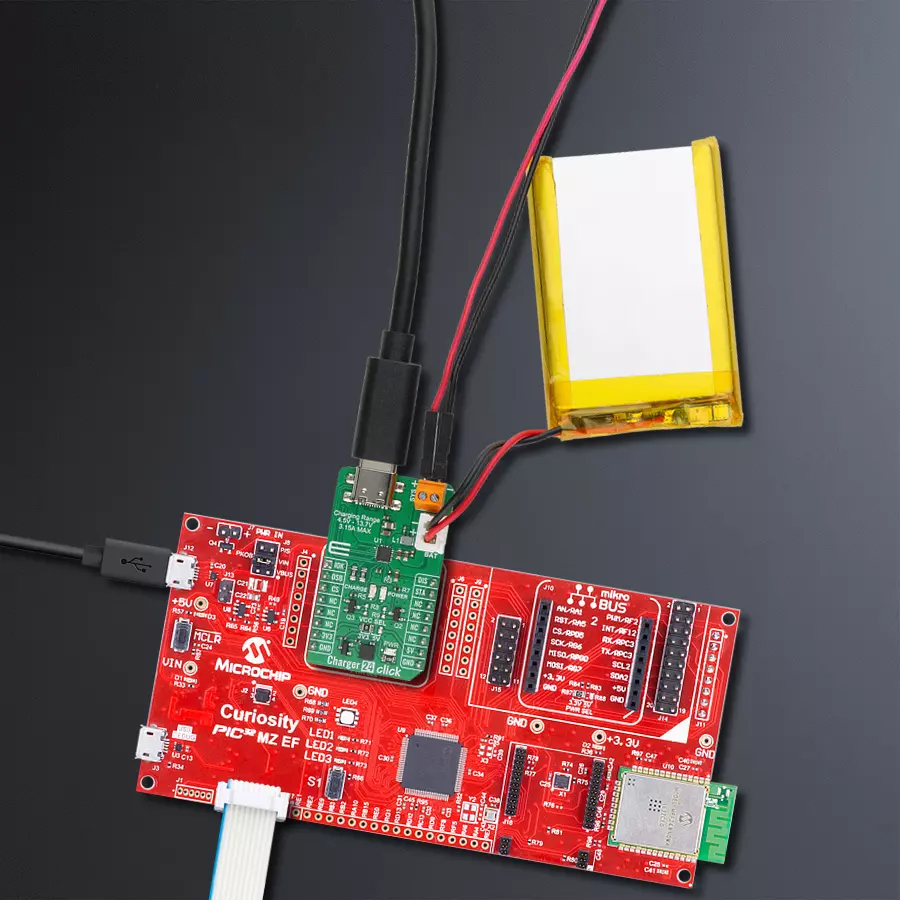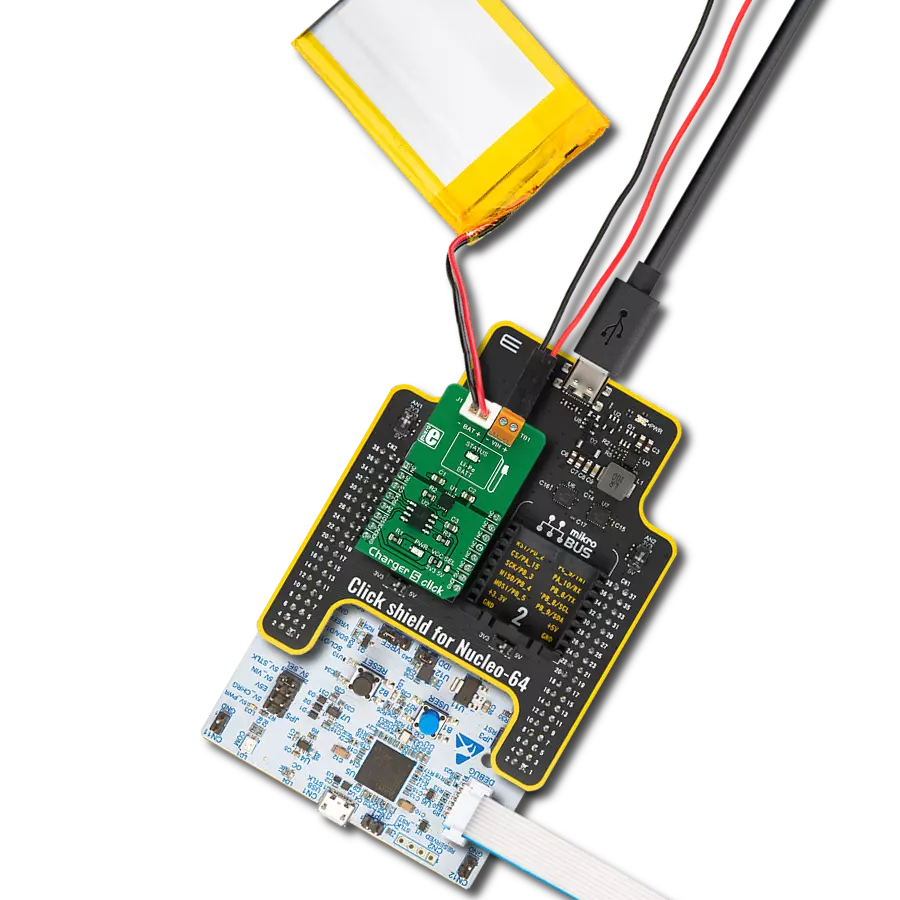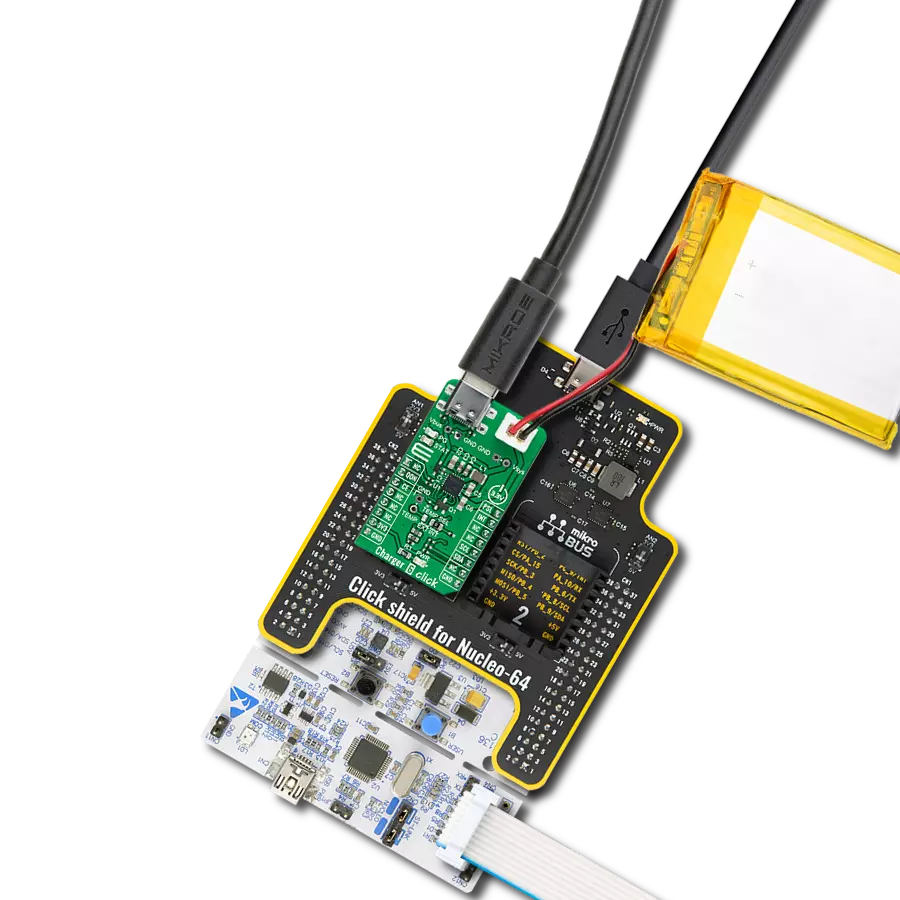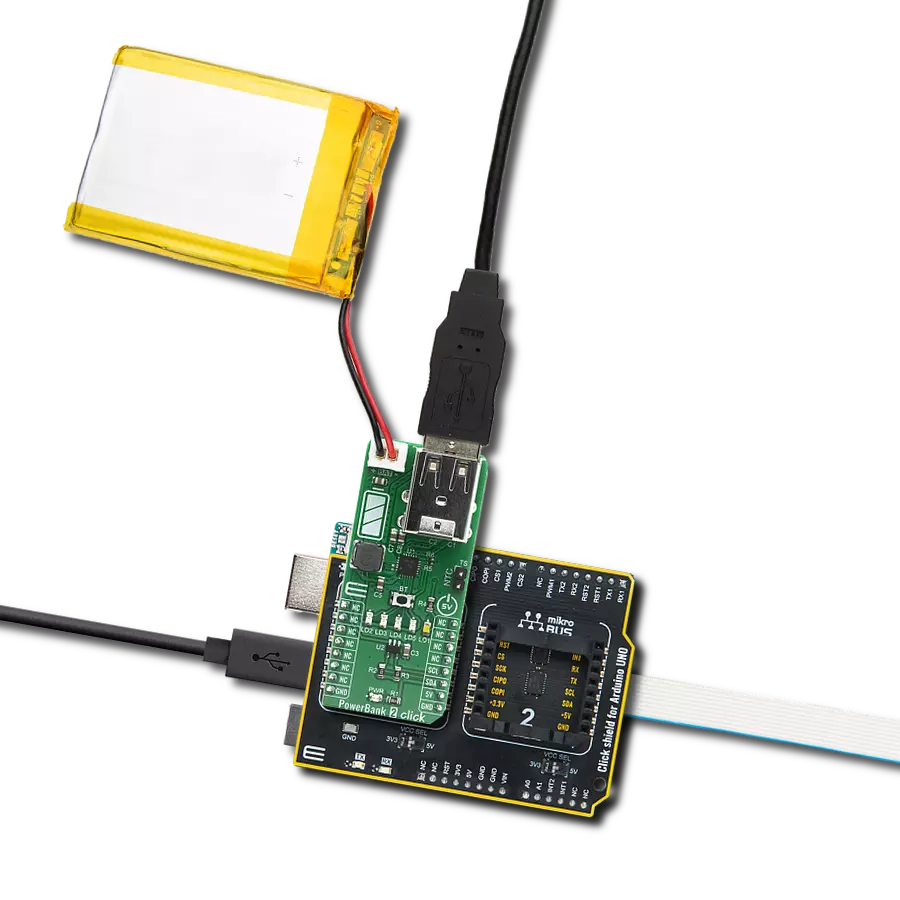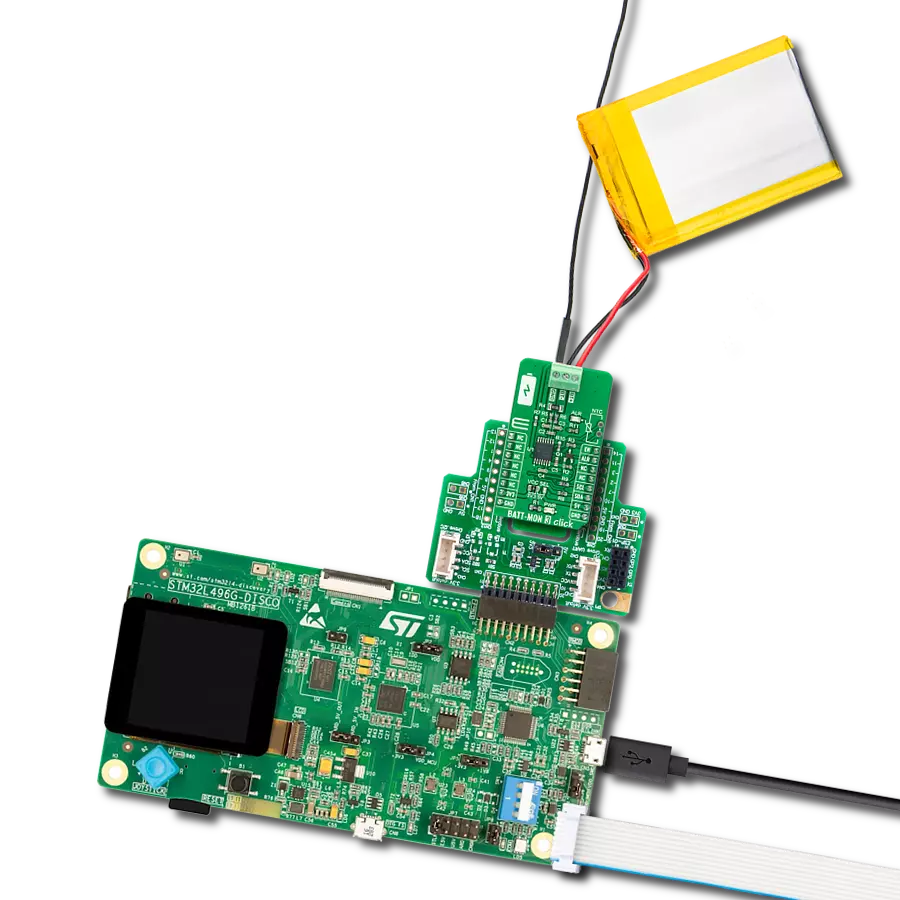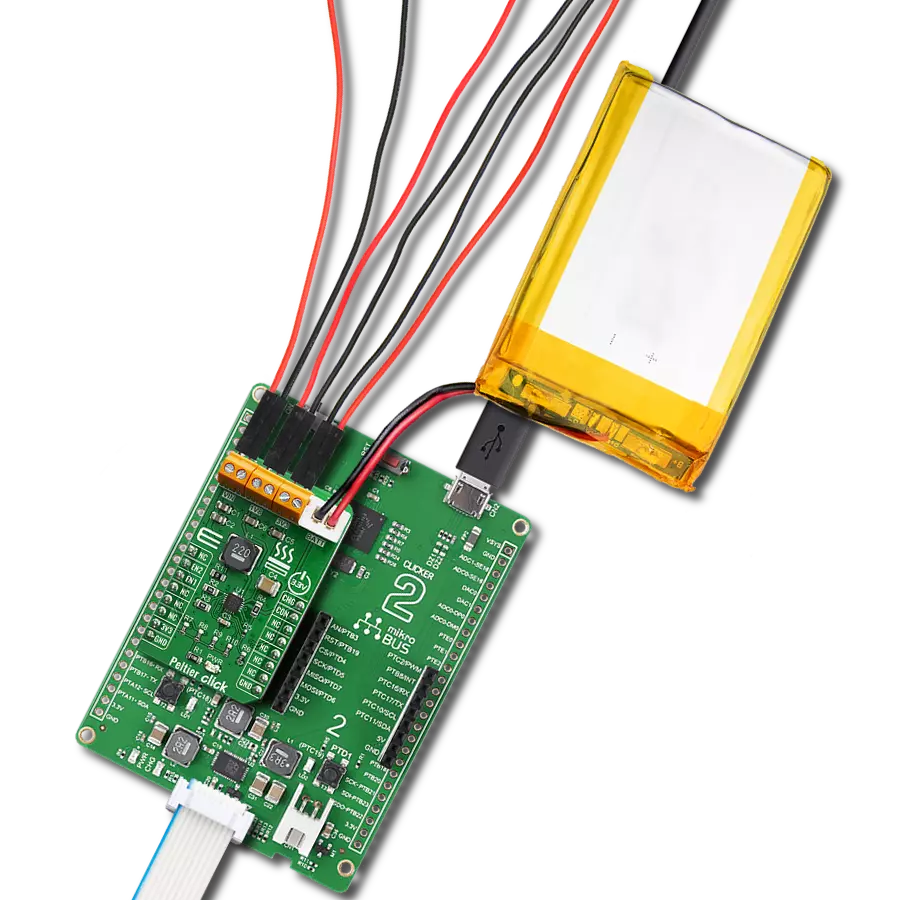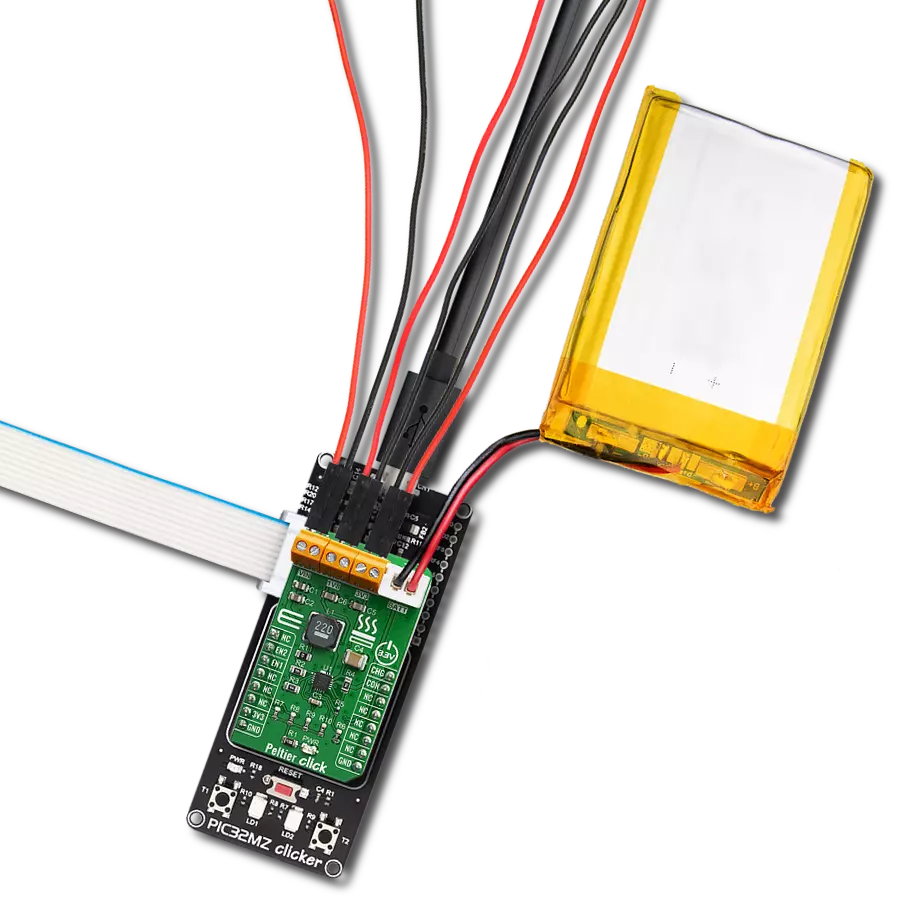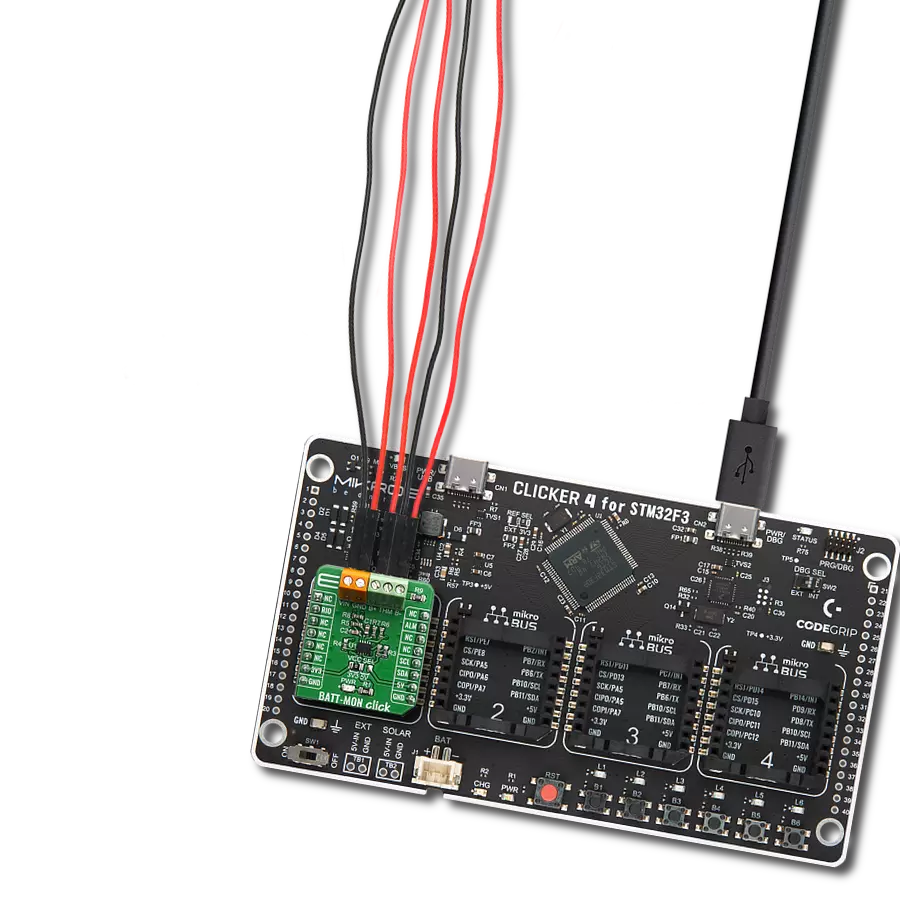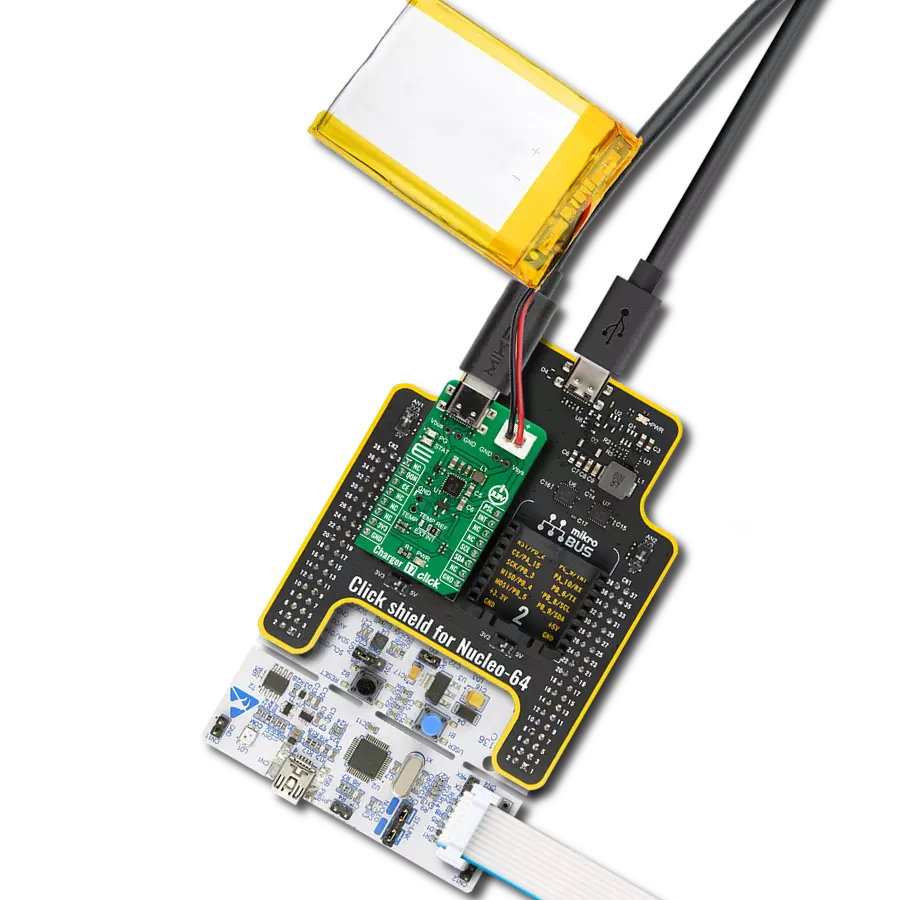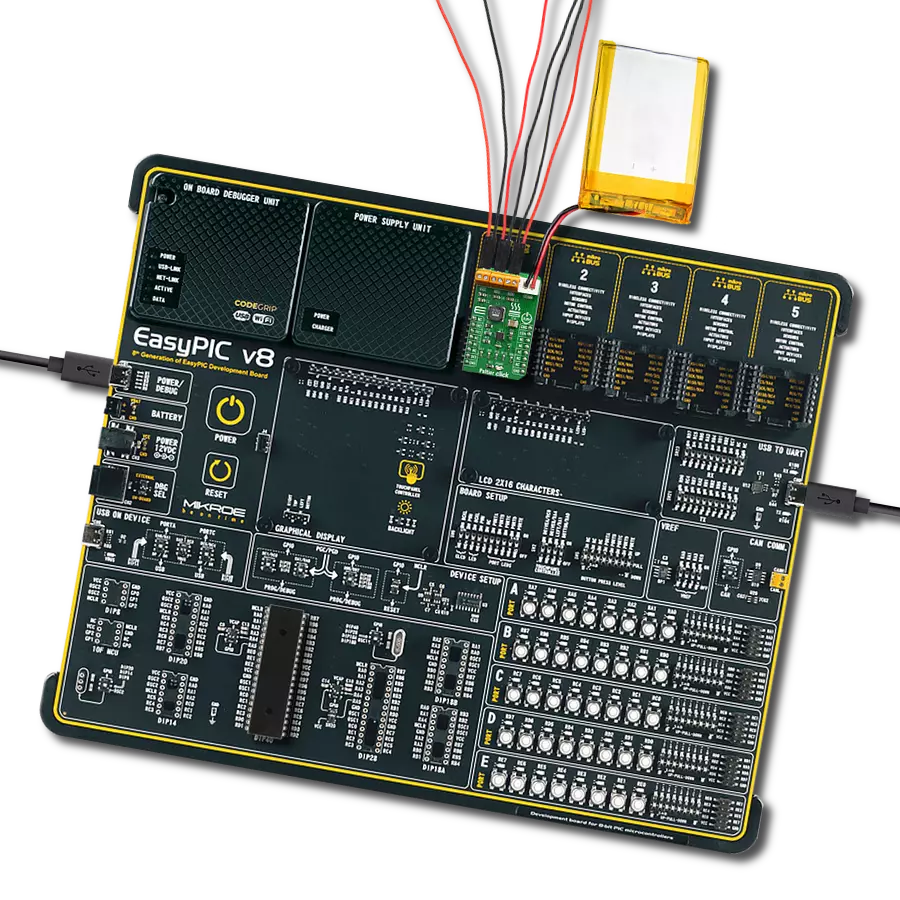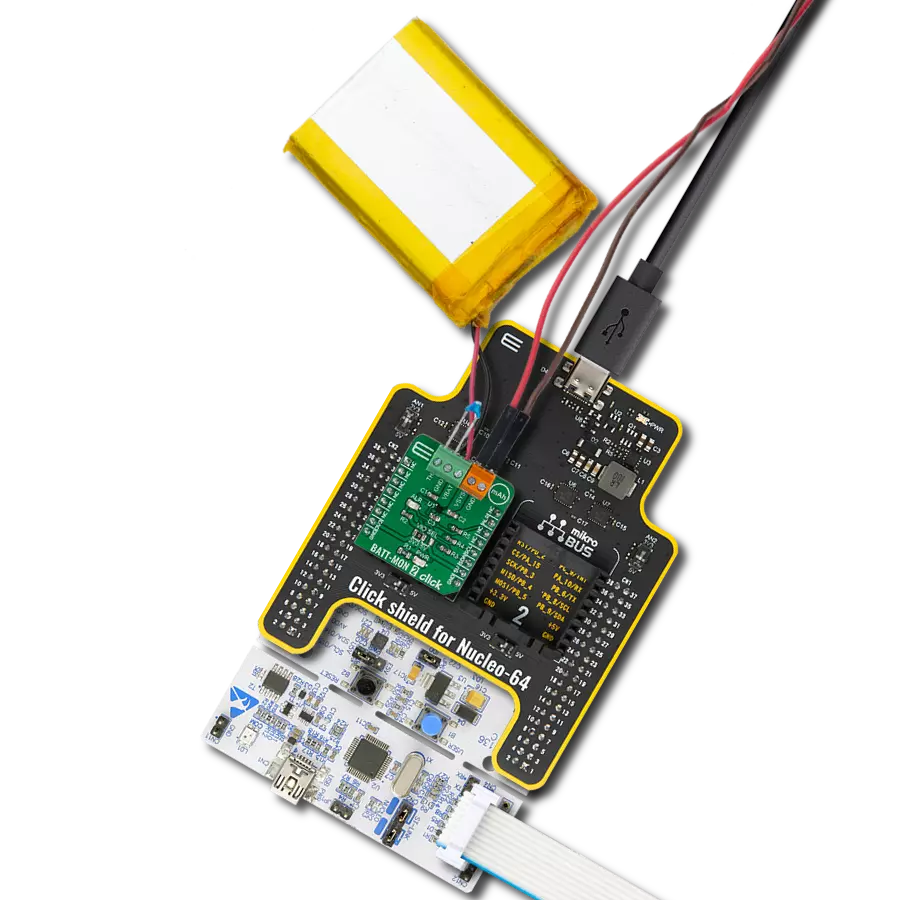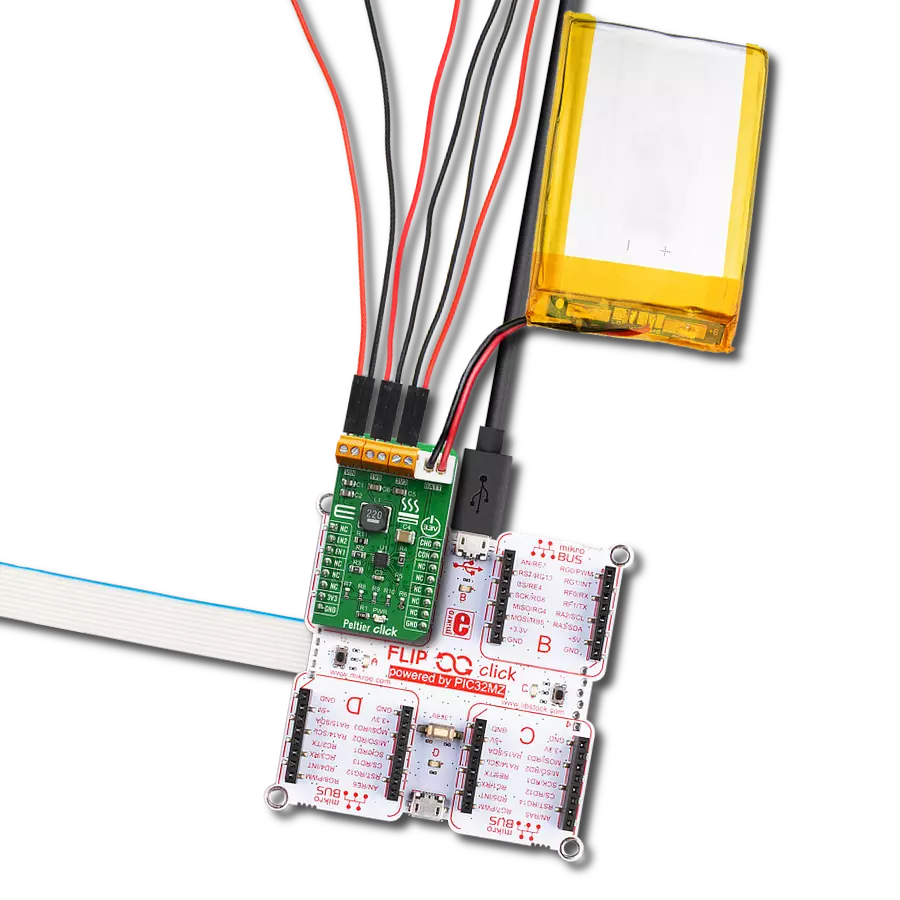USB-C Li+ battery charging with up to 3.15A and smart power routing for portable devices
A
A
Hardware Overview
How does it work?
Charger 24 Click is based on the MAX77751, a USB-C autonomous charger IC from Analog Devices for single-cell lithium-ion or lithium-polymer batteries in portable applications. This charger supports power negotiation with USB Type-C power sources through its integrated Configuration Channel (CC) detection pins, which enable automatic source identification and input current limit configuration without requiring software intervention. At its core, the MAX77751 has a synchronous switch-mode DC-DC converter capable of operating in both buck and boost modes, ensuring efficient power conversion. While in charging mode, the device operates as a buck converter, accepting input voltages from 4.3V to 13.7V and delivering up to 3.15A of current to the battery without the need for external MOSFETs. The charging current can be set between 500mA and 3.15A using an external resistor; the default 24.9kΩ resistor on Charger 24 Click provides a fast charge current of 3.15A. The Charger 24 Click is an
excellent solution for a wide range of battery-powered applications, including mobile point-of-sale terminals, wireless headphones, portable medical equipment, GPS trackers, wearable device cradles, power banks, and mobile routers. The MAX77751 also includes adaptive input current limiting (AICL), a protective feature that reduces the input current dynamically to prevent undervoltage situations when using weaker or unstable power adapters. In addition to USB-C compatibility, the IC supports BC1.2 detection through its D+ and D- pins, enabling automatic identification of legacy USB and proprietary charging sources upon insertion of the USB plug. The Charger 24 Click also features reverse-boost functionality, allowing it to supply up to 5.1V at 1.5A to external devices when the DSB pin is pulled LOW, enabling applications such as powering peripherals from the battery. For system monitoring, the board includes a red LED linked to the STA pin to indicate charging activity and a green LED on
the IOK pin to signal valid input voltage. Charging can be disabled at any time by setting the DIS pin to a HIGH logic level. Although the MAX77751 does not provide over-discharge protection, it is equipped with a SYS output that supports system powering via the integrated Smart Power Selector™. This feature prioritizes powering the system directly from the board and routes any excess power to the battery, allowing system startup even when the battery is missing or deeply discharged. It also intelligently supplements insufficient board current with power from the battery when necessary. This Click board™ can operate with either 3.3V or 5V logic voltage levels selected via the VCC SEL jumper. This way, both 3.3V and 5V capable MCUs can use the communication lines properly. Also, this Click board™ comes equipped with a library containing easy-to-use functions and an example code that can be used as a reference for further development.
Features overview
Development board
Curiosity PIC32 MZ EF development board is a fully integrated 32-bit development platform featuring the high-performance PIC32MZ EF Series (PIC32MZ2048EFM) that has a 2MB Flash, 512KB RAM, integrated FPU, Crypto accelerator, and excellent connectivity options. It includes an integrated programmer and debugger, requiring no additional hardware. Users can expand
functionality through MIKROE mikroBUS™ Click™ adapter boards, add Ethernet connectivity with the Microchip PHY daughter board, add WiFi connectivity capability using the Microchip expansions boards, and add audio input and output capability with Microchip audio daughter boards. These boards are fully integrated into PIC32’s powerful software framework, MPLAB Harmony,
which provides a flexible and modular interface to application development a rich set of inter-operable software stacks (TCP-IP, USB), and easy-to-use features. The Curiosity PIC32 MZ EF development board offers expansion capabilities making it an excellent choice for a rapid prototyping board in Connectivity, IOT, and general-purpose applications.
Microcontroller Overview
MCU Card / MCU
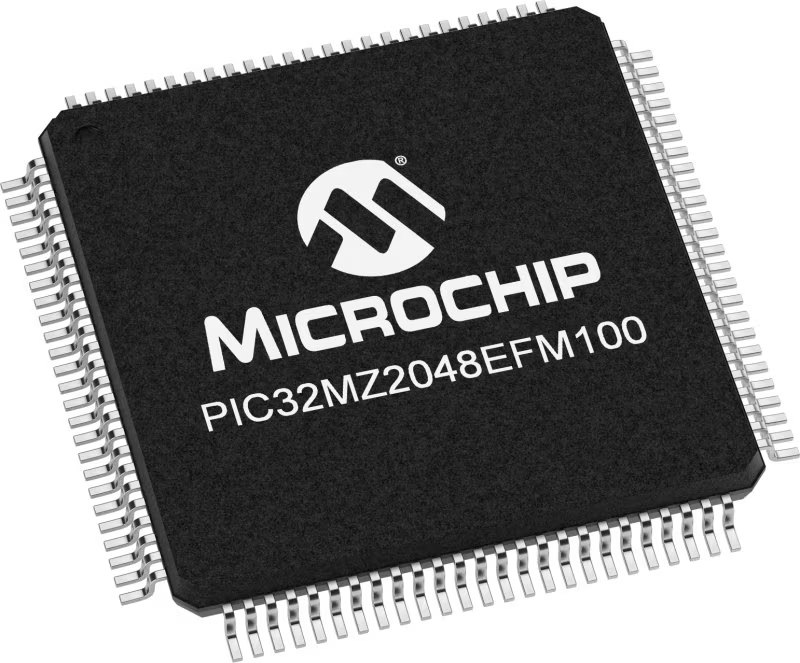
Architecture
PIC32
MCU Memory (KB)
2048
Silicon Vendor
Microchip
Pin count
100
RAM (Bytes)
524288
You complete me!
Accessories
Li-Polymer Battery is a reliable power solution designed to provide stable and long-lasting energy for portable and autonomous devices. With a rated voltage of 3.7V and an impressive 6000mAh capacity, it ensures extended operation time for applications that demand mobility without compromising performance. This battery is equipped with a standard connector fully compatible with mikromedia boards, allowing easy integration into your development or end-use systems. Its compact form factor (67 x 99 x 8.1mm) makes it ideal for space-constrained designs while still delivering a high energy density. Engineered for stable operation, it offers a smooth performance curve across usage cycles, making it suitable for both prototyping and commercial applications. To guarantee the battery arrives in perfect condition, it is shipped in secure, custom-designed packaging. Whether you're powering handheld devices, wearables, or mobile embedded systems, this Li-Polymer Battery provides a dependable and efficient energy source for your next innovation.
This is a USB 3.1 cable with USB Type C male connectors on both sides. Cable comes with USB Type C Female to USB Type A Male adapter, making it compabitle with USB 2.0 and USB 3.0 host slots as well. Cable is 1.5 meters long and compatible with any USB type C development tools.
Used MCU Pins
mikroBUS™ mapper
Take a closer look
Click board™ Schematic
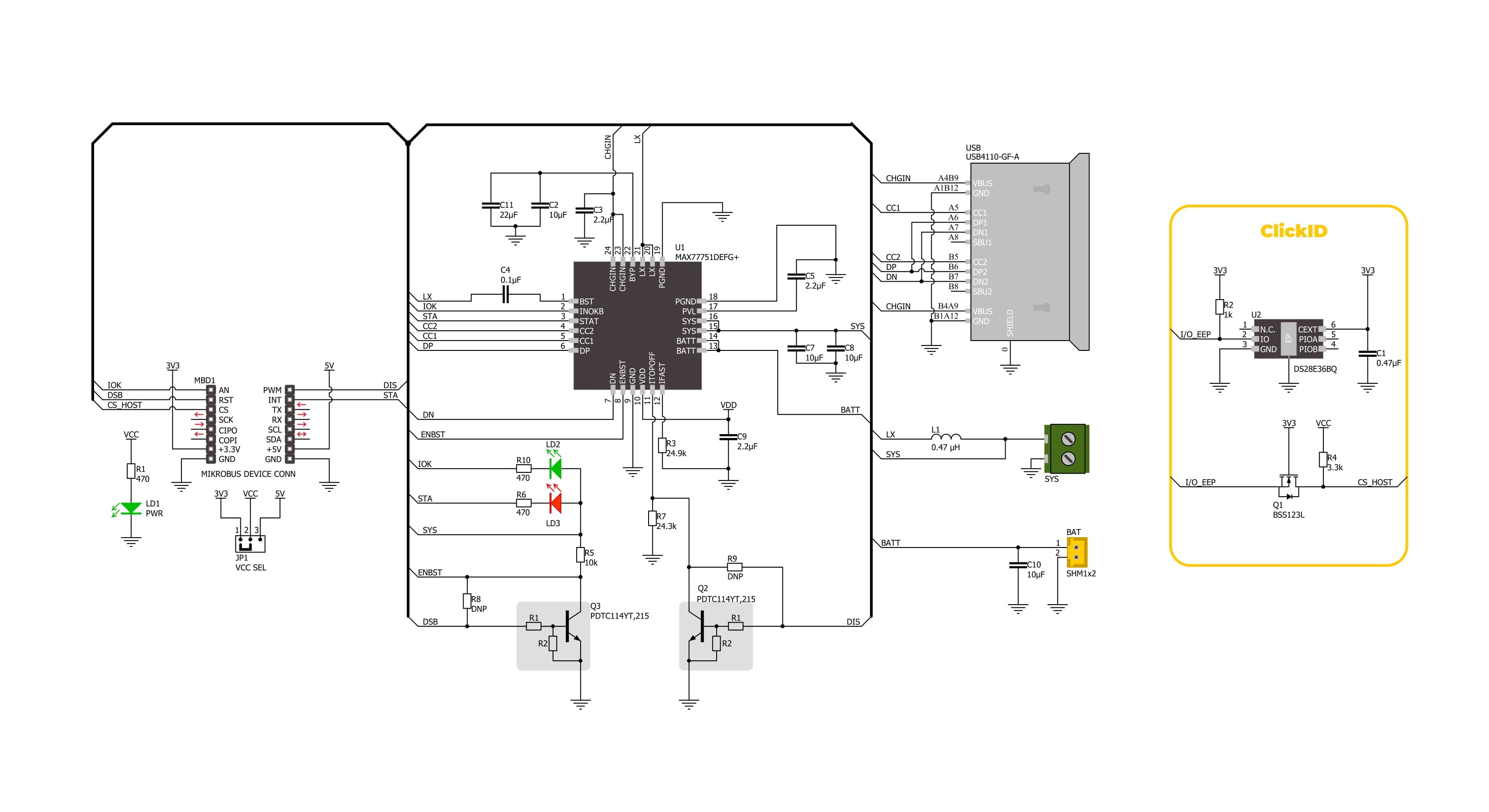
Step by step
Project assembly
Track your results in real time
Application Output
1. Application Output - In Debug mode, the 'Application Output' window enables real-time data monitoring, offering direct insight into execution results. Ensure proper data display by configuring the environment correctly using the provided tutorial.

2. UART Terminal - Use the UART Terminal to monitor data transmission via a USB to UART converter, allowing direct communication between the Click board™ and your development system. Configure the baud rate and other serial settings according to your project's requirements to ensure proper functionality. For step-by-step setup instructions, refer to the provided tutorial.

3. Plot Output - The Plot feature offers a powerful way to visualize real-time sensor data, enabling trend analysis, debugging, and comparison of multiple data points. To set it up correctly, follow the provided tutorial, which includes a step-by-step example of using the Plot feature to display Click board™ readings. To use the Plot feature in your code, use the function: plot(*insert_graph_name*, variable_name);. This is a general format, and it is up to the user to replace 'insert_graph_name' with the actual graph name and 'variable_name' with the parameter to be displayed.

Software Support
Library Description
Charger 24 Click demo application is developed using the NECTO Studio, ensuring compatibility with mikroSDK's open-source libraries and tools. Designed for plug-and-play implementation and testing, the demo is fully compatible with all development, starter, and mikromedia boards featuring a mikroBUS™ socket.
Example Description
This example demonstrates the use of the Charger 24 Click board. The application initializes the device, enables battery charging, and continuously monitors the charging and USB power status. It displays whether the battery is currently charging, fully charged, or if no input is detected, as well as whether the USB power is valid.
Key functions:
charger24_cfg_setup- Examplecharger24_init- Examplecharger24_enable_charging- Examplecharger24_get_iok_pin- Examplecharger24_get_status- Example
Application Init
Initializes the logger and the Charger 24 Click driver and enables charging while disabling boost mode.
Application Task
Periodically reads and logs the charging and USB power status.
Open Source
Code example
The complete application code and a ready-to-use project are available through the NECTO Studio Package Manager for direct installation in the NECTO Studio. The application code can also be found on the MIKROE GitHub account.
/*!
* @file main.c
* @brief Charger 24 Click example
*
* # Description
* This example demonstrates the use of the Charger 24 Click board. The application
* initializes the device, enables battery charging, and continuously monitors the
* charging and USB power status. It displays whether the battery is currently
* charging, fully charged, or if no input is detected, as well as whether the USB
* power is valid.
*
* The demo application is composed of two sections:
*
* ## Application Init
* Initializes the logger and the Charger 24 Click driver and enables charging while disabling boost mode.
*
* ## Application Task
* Periodically reads and logs the charging and USB power status.
*
* @note
* Ensure a valid USB input source and battery are connected to observe status transitions.
*
* @author Stefan Filipovic
*
*/
#include "board.h"
#include "log.h"
#include "charger24.h"
static charger24_t charger24; /**< Charger 24 Click driver object. */
static log_t logger; /**< Logger object. */
void application_init ( void )
{
log_cfg_t log_cfg; /**< Logger config object. */
charger24_cfg_t charger24_cfg; /**< Click config object. */
/**
* Logger initialization.
* Default baud rate: 115200
* Default log level: LOG_LEVEL_DEBUG
* @note If USB_UART_RX and USB_UART_TX
* are defined as HAL_PIN_NC, you will
* need to define them manually for log to work.
* See @b LOG_MAP_USB_UART macro definition for detailed explanation.
*/
LOG_MAP_USB_UART( log_cfg );
log_init( &logger, &log_cfg );
log_info( &logger, " Application Init " );
// Click initialization.
charger24_cfg_setup( &charger24_cfg );
CHARGER24_MAP_MIKROBUS( charger24_cfg, MIKROBUS_1 );
if ( DIGITAL_OUT_UNSUPPORTED_PIN == charger24_init( &charger24, &charger24_cfg ) )
{
log_error( &logger, " Communication init." );
for ( ; ; );
}
charger24_disable_boost ( &charger24 );
charger24_enable_charging ( &charger24 );
log_info( &logger, " Application Task " );
}
void application_task ( void )
{
uint8_t status = charger24_get_status ( &charger24 );
log_printf( &logger, "\r\n Charging status: " );
switch ( status )
{
case CHARGER24_STATE_NO_INPUT:
{
log_printf( &logger, "No input or fault\r\n" );
break;
}
case CHARGER24_STATE_CHARGING:
{
log_printf( &logger, "Trickle, precharge, fast charge\r\n" );
break;
}
case CHARGER24_STATE_CHARGE_DONE:
{
log_printf( &logger, "Top-off and done\r\n" );
break;
}
default:
{
log_printf( &logger, "Unknown\r\n" );
break;
}
}
log_printf( &logger, " USB status: " );
if ( charger24_get_iok_pin( &charger24 ) )
{
log_printf( &logger, "No power\r\n" );
}
else
{
log_printf( &logger, "Power good\r\n" );
}
}
int main ( void )
{
/* Do not remove this line or clock might not be set correctly. */
#ifdef PREINIT_SUPPORTED
preinit();
#endif
application_init( );
for ( ; ; )
{
application_task( );
}
return 0;
}
// ------------------------------------------------------------------------ END
Additional Support
Resources
Category:Battery charger
